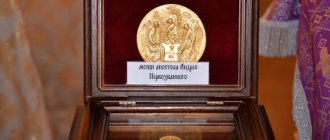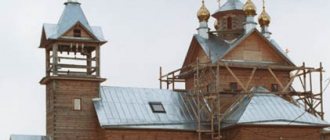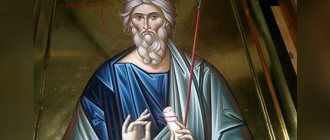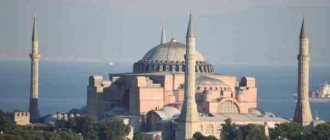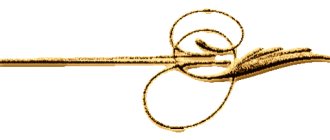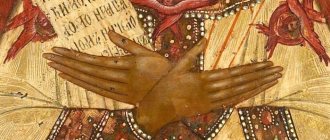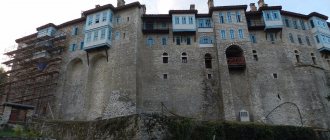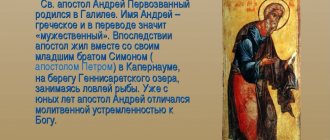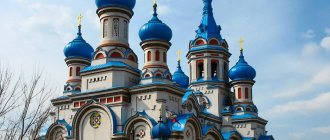Icon "Christ the Vine"
The extraordinary icon “Christ the Vine,” dedicated to the image of the Savior, is the most holy image that helps in any troubles and misfortunes.
The image of Christ "The Vine" is a symbol of wisdom and prosperity. This icon is famous among Christians and has special reverence and respect. A huge number of believers offer their prayers before the miraculous image, which contains enormous divine power that can help in life’s difficulties and sorrows.
History of the icon “Christ the Vine”
The appearance of the image dates back to the 15th century. The first icon was painted by a monk who served at one of the monasteries in Greece.
As already mentioned, this icon symbolizes sanity of mind, prosperity and well-being. The Orthodox image is called “The Grapevine” for a reason, for in the Gospel itself the Savior is repeatedly called that way.
For Orthodox believers, the icon quickly became one of the most revered and beloved holy images. Many Christians from all over the world pray before the miraculous face, which always helps true believers.
Where is the miraculous image of the Savior “The Grapevine” located?
The glorified face of Christ, which is often called the “True Vine,” is a rare and unique icon that is not found in churches in every country. In Russia, the shrine can be found in the following holy monasteries:
- Moscow, “Temple in the Name of the Icon of the Blessed Virgin Mary”;
- St. Petersburg, Church of the Savior on Spilled Blood.
Description of the icon
There are several options for writing the most holy image of Christ “The Vine”. But only two of them are considered the most common and beloved by Orthodox believers.
A later version of the icon depicts Jesus among a spreading vine. Many branches unravel from it, where the Mother of God is located, and with her St. John and the other great apostles. Thus, the icon directly depicts words from the Gospel.
Another, no less famous image depicts the Savior, but the plot deviates from the texts of Holy Scripture. In the divine hands of Jesus, life sprouts in the form of a vine, from which He squeezes the juice onto the sacred Chalice for Communion.
What do they pray for before the miraculous image?
This shrine can help believers in any trouble and in various life difficulties. But Orthodox people more often offer their prayers before the image of the Savior “Christ the Vine” with requests:
- about getting rid of fears, vices and depressing thoughts;
- about salvation from evil intentions, enemies and enemies who want suffering;
- about maintaining family happiness, harmony and getting rid of quarrels;
- about good health, strong faith and good, sincere thoughts and actions;
- about maintaining peace of mind.
Days of celebration
There is no official date for the celebration of this image of Christ in the calendar of the Russian Orthodox Church. Many believers set aside one day a year for glorification and special veneration of the icon - May 29.
Prayer before the holy icon “Christ the Vine”
“Oh, Great Savior, true son of the Lord! We turn to You in the words of our prayer asking for help and support in difficult times! Shelter from troubles and sorrows, protect from quarrels and discord in the family! Take the enemies away from our homes and heal our sinful souls. Guide me on the righteous path and do not let me stray from the right path. Only You are able to help us, O our Holy Guardian! We will not stop glorifying Your name! Let Your will be done! Forever and ever. Amen".
Only true believers in the power of the Lord and the miraculous abilities of the holy icon can receive the support and protection of Christ. Offer the words of prayer with pure thoughts and from the depths of your heart, then your life will certainly change for the better, and troubles will pass you by. We wish you peace in your soul, and do not forget to press the buttons and
Lord have mercy.
1 Blessed is the man who does not walk in the counsel of the wicked, nor stand in the way of sinners, nor sit on the seats of the destroyers, 2 but his will is in the law of the Lord, and in His law he shall learn day and night. 3 And it shall be like a tree planted by the rising of the waters, which shall yield its fruit in its season, and its leaf shall not fall off, and all that he createth shall prosper. 4 Not like wickedness, not like this, but like dust that the wind sweeps away from the face of the earth. 5 For this reason the wicked will not rise again for judgment, below the sinner for the council of the righteous. 6 For the Lord preaches the way of the righteous, and the way of the wicked shall perish.
Story PRAYER
The village of Strugi, where Father Anatoly lives, is quiet, poor, log-built and famous only throughout the entire district for its dense lilac gardens. A long time ago, some passer-by assured the women that the lilac tree protects from all pestilence, so they welcomed this tree into their home and allowed it to unfold from edge to edge.
During the lilac season the village is not visible. If you look at it from a distance, you will see one thick purple cloud lying on the ground.
At this time I spent the night with Father Anatoly. Our scholars and scholars consider him a “wretched priest,” since he is poor in intelligence, has little education, is unpretentious in appearance, and his sermons are awkward, like peasant speech.
“But he believes in God so much,” those who loved him said in response, “that he can perform miracles!”
They assured me almost with an oath: when Father Anatoly prays, the lamps and candles light up by themselves! The windows of the priest's upper room were open to the garden, to the white night, all in lilacs, dawns and nightingales. Father Anatoly was sitting on the windowsill and turned in my direction several times, apparently waiting for me to fall asleep. I pretended to be asleep. Father Anatoly took off his shabby patched cassock and put on a white one, from under which the peasant's tar boots were visible. He was preparing for something. Combing his dusty reddish beard and the same hair with a comb, his hand trembled. It seemed to me that a spasm passed over his rough peasant face and thoughtfulness lay between his thick eyebrows.
I am the true vine
I am the true vine, and My Father is the vinedresser. Every branch in me that does not bear fruit He cuts off, and every branch that bears fruit He purges, so that it may bear more fruit” (John 15:1-2).
Our Lord and God Jesus Christ calls Himself the Vine, and calls us all branches of this vine. Listen further to what He says: “You have already been cleansed through the word that I preached to you. Abide in Me, and I in you. Just as a branch cannot bear fruit by itself unless it is in the vine, so neither can you unless you are in Me.”
This is clear to you, it is quite clear that a branch that has not retained the connection with its vine, of course, cannot bear fruit.
ICON “SAVORED THE TREE OF LIFE”
Icon of the Savior Tree of Life
The Savior Tree of Life, or, as this icon is often called, the True Savior Vine, is a Greek icon, popular in Greek iconography, but very rarely found in Rus'. Russian icon painting workshops actually do not use this content, although they are familiar with it. This is probably one of the most conventionally symbolic images of the iconography of Christ.
The Savior Himself is depicted on such an icon in the center, in the form of a Pantocrator - Jesus the Pantocrator, the Omnipotent Arbiter and the Heavenly King, the Lord. The image of Jesus himself is quite suitable for one of the six main canonical iconographic types, generally recognized according to Orthodox tradition. The difference here is that the Almighty is seen as a tree trunk, on the branches of which medallions with images of the apostles of His Church are placed. The symbolism of the images of this icon goes back to the words from the Gospel of John: “I am the real vine, and My Father is the vinedresser. Any vine I have that does not bear fruit, He cuts off; and any one that bears fruit he cleanses, so that it bears the most fruit. You are no longer purified through the word that I preached to you. Abide in Me, and I in you. Just as a branch cannot bear fruit by itself unless it is in the vine, so neither can you unless you are in Me. I am the vine, and you are the branches; He who abides in Me, and I in him, bears much fruit; for without Me you can do nothing. Whoever does not abide in Me will be cast out like a branch and wither; and such [branches] are gathered and thrown into the fire, and they are burned” (John 15: 1-6).
The Icon of the True Savior depicts not only the Savior himself, but also His entire Church. According to Jesus himself, He is considered the trunk, people are His branches. The Church is an active, changing and developing organism, like a tree or a vine, the center and base of which is considered to be Jesus, but the branches, shoots and even small leaves are probably like individual people, religious, fresh people, the All-Merciful, becoming a single family . Speaking about Himself as the True Vine, Jesus prepares disciples, apostles - and through them the entire Church, every member of it - as participants in their own life. The Church does not just gather around Christ - it unites with Him, constitutes His Body. And although each individual person in this organism retains his individuality and freedom, through love he is included in the unity of the Mystical Body. Through the sacraments, believers, members of the Church, are united with Christ. Therefore, the central, main sacrament of the Church is the Eucharist, communion of Body and Blood, bread and wine - the basis of the liturgy. And the icon of the True Savior Vine also reminds us of this.
The founder of the Alexandrian theological institution, Clement of Alexandria, a late second-century missionary and Christian apologist, wrote: “The grapes give wine, as the Word gave His blood.” For members of the Church, the vine and bunches of ripe grapes are a sign of heaven, a sign of the future Kingdom of God.
Images of the apostles, disciples of Christ, whom He sent to preach and expand the Christian faith, are usually symbolic. The Supreme Messenger Peter is constantly depicted with a bunch of keys - the keys to the Kingdom of Heaven, that is, the Church Sacraments (images personified by the keys). The Evangelists Mark, Luke, Matthew and John are depicted with books of the Gospels, while the Apostle John can be distinguished from the others by the mountainous background outlined behind him - in memory of his work on the Gospel on the rocky peninsula of Patmos.
The Icon of the True Vine (Grape Vine) has been famous in Greece since the 15th century; it first appeared in Greek monasteries. But at first, around Christ, it depicted not only the apostles, but also the Mother of God and John the Baptist, acting as intercessors of people before the Lord. In this guise, the icon slightly resembled the Deesis san, which is the central part of the Orthodox iconostasis. At the most recent time, in the 17th century, another variant of the image of the True Vine arises - on the icon they also draw the Holy Sepulcher, from which the vine grows, or they vary the image of Christ - He holds the vine in his hands, or it grows from His pierced rib, and Himself he presses a bunch of grapes into a chalice, a cup used during Christian worship to consecrate wine. Thus, in the later versions of the icon, the Eucharistic basis of the plot was strengthened, as opposed to the older allegorical one. However, the least, oldest iconographic version remains the most frequently encountered today. In general, the symbolism of the vine is widely represented in the Bible, and in the decoration of Christian churches, and, naturally, during worship.
Grapes are a sign of wisdom, immortality, and also of blood and sacrifice. A well-groomed vineyard is a sign of peace and prosperity. Floral patterns are used wherever possible for the decoration of churches, in frames and carved crowns of icons, on interior frescoes and exterior paintings of churches, on carved bases of iconostases, platbands and tiles. The harvest of grapes is considered the emblem of the Last Judgment at the end of time. The image of the Flourishing Cross came to Rus' from Byzantium, which is determined by the symbolism of the vine - 2 blossoming branches emanate from the base of the cross as a symbol of the Resurrection, which is why it is called the Life-Giving Cross of the Lord.
And if in the Russian version of the Life-Giving Cross a plant pattern is used, then in the Greek it is a vine with leaves and clusters. The Cross of the Lord is also associated with the heavenly Tree of Life. According to this legend, a tree that grew on Adam’s grave from a wreath buried with him was used for the crucifixion of Christ. Adam wove a wreath from branches brought by his third son Seth from the tree of paradise - the Tree of Life. In the era of King Solomon, it was predicted that the Messiah would be executed on the trunk of this tree, and Solomon ordered the trunk to be drowned. But for the crucifixion of Christ, the trunk of the Tree, sunk by Solomon, was pulled out of the Pool of Siloam (the spring at which, according to the Gospel of John, Jesus healed the blind), and the Cross was made from it. Soon it became known about the Resurrection of Christ, the cross, horrified, was hidden and buried. In the 4th century St. Helena, the mother of the main Christian ruler, Constantine the Great Equal to the Apostles, undertook an investigation and found the place where the Cross was buried. But it turns out that along with the Cross of the Lord, the crosses of the villains crucified with Him were also buried. Nevertheless, the Cross of the Lord was immediately recognizable - by the living vine growing from it.
Contents of the icon
Also, this image is often called the grapevine icon, since here the grapevine tree, which represents the church, is used as a symbol.
In the center is Spas, which is like the base of the vine. Various branches branch off from it, and these branches are the apostles, the Virgin Mary and other gospel characters.
Considering the Tree of Life icon , its meaning becomes completely clear: the church is a semblance of a living organism that includes an entire community. Of course, it begins with a relatively small number of people: Christ himself and the holy ascetics. However, the church then begins to consist of the community of all Christians, that is, all people of this faith constitute the so-called body of Christ.
People in the church are united with each other, they are interconnected like ampelos (grapevine in Greek) and everyone can act in one way or another. For example, the one who chooses a heavenly existence is raised by his own branch upward and reaches the limit of Heaven. Anyone who, on the contrary, strives for nothing, becomes a dry branch, which is eventually separated from the tree in order to be burned.
In addition, the icon of the Tree with Christ gives a hint of the family tree, which represents the genealogy of each individual person.
Only in this image is a family understood as a Christian church and community in which people are related to each other.
This is the property of Christianity, which erases any boundaries and differences between people and allows everyone to enter the Kingdom of God.
The meaning of the Tree of Life icon indicates the opportunity for a believer to better understand his own involvement in the church. Before this image, any prayers are offered to Christ. It is also possible to pray to the Holy Trinity or the Holy Spirit in front of this image.
What is depicted on the icon?
In the center of the canvas, Jesus Christ is depicted, and it is as if he is chained to a tree and his hands are like branches. This is if we talk about the famous painting of the 14th century, the author of which is Pacino di Buanoguida.
Branches extend from the trunk. There are six branches and they have inscriptions. Each of them has four medallions with Christian scenes, which display different virtues of Christ.
The last branch in the upper right corner symbolizes the entrance to heaven. In earlier icons, the symbol of God’s parental love for people and the redeemed sacrifice of Jesus is the image of a nest with a pelican. The bird has torn its chest and feeds its children with its own blood.
According to legend, the tree of life was grown by the Lord himself in the Garden of Eden. Every month the tree bears fruit, and the leaves have healing powers and heal people from illnesses. The tree itself is a symbol of life and immortality, since thanks to the fruits grown on it, it can be obtained.
In later versions, the icons are heroes from Holy Scripture. At their head sit the Mother of God and Jesus Christ.
Most often they depict Jesus Christ surrounded by his apostles. Or, in the center, the Mother of God with her baby is depicted, surrounded by sixteen Mothers of God.
Icon of the Tree of the Blessed Virgin Mary
Compositionally, this option is practically no different from the previous one, but here the basis is the Tree of the Virgin Mary. In the center there is a scene of the birth of Christ, and on the branches there are various images of the Blessed Virgin.
The name of the icon “Mountain Jerusalem” is also used, which indicates the resurrection and the opportunity for every believer to find himself in the Heavenly Jerusalem. To do this, you just need to keep the commandments on earth. Then, after the end of times, the righteous will ascend there. The Heavenly City itself is depicted on one of the edges of the image, hidden behind a haze.
You should also consider the meaning of the icon of Mount Jerusalem, where the central part is occupied by the scene of the birth of the Savior. This event focuses attention and is central in every sense, only thanks to this the rest became possible. On the branches there are various images of the Virgin Mary with the baby; they invite the believer to look at different variations of the relationship between the Mother of God and the baby.
Also symbolically, this diversity indicates various options for the relationship between the believer and the Lord. The soul strives for the Lord in different ways and establishes a whole range of relationships. It was thanks to the birth of Christ that these relationships became not only possible, but also make it possible to gain the Kingdom of Heaven.
As a rule, prayer to the icon of the Tree of the Blessed Virgin Mary is said in solitude. Therefore, a small space in the house is often set aside for this, which allows you to move a little away from the hectic world and turn to the image. Each image that contains the icon of the Tree of the Virgin Mary helps in something separate.
Therefore, prayer in front of this icon can be used to receive a wide variety of benefits.
“This grape... Thy right hand planted it”
Garden of Eden. Mosaic. Italy, VI century
Reflecting in its entirety the history of the salvation of mankind, as it is set out in the Holy Scriptures, the icon tells us not only about Christ, the Most Holy Theotokos, the saints, but about the entire world around us. The interior and landscapes, fauna and flora find their rightful place here. We talked about “small and great” animals on icons and frescoes in the last issue of the magazine, today we turn to the world of plants. Like any detail of the iconographic space, these modest creations are placed in the composition not only “for beauty” - they have a special, spiritual meaning.
Gardens and vineyards
The history of man began not in the desert, but in the Garden of Eden. This “helicopter garden” was planted by the Lord, the Gardener, in the universe He created. The history of human suffering, opening in the same garden with the catastrophe of the Fall, at the end of centuries leads humanity to the hope of the Garden of Gethsemane: among its trees, the Lord prays for the cup of suffering to pass, but accepts the will of the Heavenly Father.
The work of Salvation is accomplished, and the burial of the Dead on the Cross also takes place in the garden: on Golgotha, not far from the place of crucifixion. It was not for nothing that the weeping Mary Magdalene, not finding the body of the Lord in the tomb (burial cave), turned to Him, resurrected and not recognized by her, as a vinedresser.
Many pages of the Gospel are entwined with vines - references to the vineyard and winegrowers. Even the first miracle of Christ was the transformation of water into wine at a wedding in Cana of Galilee.
Just as the Lord is at the same time the Shepherd and the sacrificial Lamb, so at the same time He is both the vinedresser and the “true vine,” the wine of which is offered to those who believe in the Blood of the Lord during the sacrament of Communion. Christians, following the apostles, are branches of this vine, having no life apart from It: “I am the vine, you are born... because without Me you can do nothing” (John 15:1). It is this meaning of the Gospel text that is reflected in the icon “The Savior is the True Vine.”
Christ often uses the same images in parables: about the evil vinedressers, about the workers in the vineyard. All of us, God’s creations, are workers in His heirloom, diligent or careless.
Christ the Vine True. Icon. Greece, XV century
“Bugs” under the saint’s feet: this is how grass is depicted on the icon
Tree on the icon of the Transfiguration of the Lord. Russia, XVI century
Children cutting palm branches. Fragment of the fresco “The Entry of the Lord into Jerusalem.” Georgia, XIV century.
Expulsion of Adam and Eve from Paradise. Fresco. Serbia, XIV century. Behind the wall of Paradise grow “thorns” and “thistles”
“And he will be like a tree planted by streams of water...” (Ps. 1:3). Miniature from the Psalter of Theodore. Byzantium, XI century
"Bugs" on the ground
The Garden of Eden, lost after the Fall, scattered in island-oases along the icon hills, along the fresco and mosaic fields of church interiors - with individual grasses, trees, flowers.
Pozem - this is the name given to the background of greenish-brown shades in the lower part of the icon - this is the ground under the feet of those depicted in the image. Small vegetation (various grass-ants) appears in the form of intricate squiggles scattered throughout the ground, which icon painters call “bugs.” Larger trees are painted in the form of elegant, fantastically shaped bushes, reminiscent of myrtle trees; Here and there you can see white flowers and even berries on their branches.
In addition to the aforementioned plant “trifles,” there are also more significant specimens, both in size and significance.
Patriarchs of the Bible Garden
A powerful tree drinking up soil moisture with its roots, for example, the psalm “tree planted by springs of water” (Ps. 1:3) is an image of a righteous man feeding on the life-giving water of the Lord’s teachings. The greatest of these plants is the Mamrian oak, under which the forefather Abraham received the Holy Trinity. Oak is an invariable detail of the Trinity icon, a symbol of the Tree of Life, which the Lord planted in Paradise.
The Scriptures mention “cedars of Lebanon” (fir trees), common cedars, cypresses, olives, mustard trees, laurel, pomegranates and many others, almost always serving as the basis of an exquisite metaphor: “I have risen like the cedar of Lebanon and like the cypress tree of the mountains of Hermon" (2 Kings 2:7).
The palm tree has long been considered a sign of celebration among Jews. During processions, it was customary to throw palm branches at the feet of the winner. This is exactly what we see in the icon “The Entry of the Lord into Jerusalem” (John 13:13, Matthew 21:8).
Curse of the fig tree. Miniature from the Four Gospels of Tsar John Alexander. Bulgaria, XIV century.
Fig tree
Not only a person, but also a tree can go against the will of the Creator and therefore die. Such is the barren fig tree, cursed by Christ and instantly withered (Mark 11:12-14).
It’s as if it’s a shame for the fig tree, because the adjacent lines say that it was not yet time for figs. However, you need to know the characteristics of this oldest of cultivated plants. The fig tree (or fig) usually bears fruit at least three times per season, with the first berries ripening before the tree even leaves. Not finding fruit among the lush foliage, the Lord rightly considered the plant barren.
The fig tree is mentioned in Scripture many times, and in one case this tree did bear fruit and served to save a person. It was on the fig tree that the rich publican Zacchaeus, short in stature, climbed when he wanted to see the Lord walking past the crowd.
Thus, the fig tree appears in the Gospel as a symbol of both a barren soul and a soul longing for a meeting with God.
Seeds and weeds, thorns and thistles
The Lord is not only a gardener, but also a sower who sows the seeds of the gospel into hearts.
What will grow from this good wheat depends, firstly, on the heart itself, that is, the soil where the grain falls. This is the parable of the sower (Matthew 13:3-8).
In addition, worthy fruits grow together with harmful ones due to the machinations of the enemy of the human race. “Mister! Did you not sow good seed in your field? where does the tares come from?” - the angels ask the Lord in another parable (Matthew 13:24-30, 36-42). “The enemy man did it,” He replies. Outwardly, tares look like wheat, so until the harvest - the end of the world - the Lord does not allow weeds to be weeded out, so as not to damage the good ones.
And finally, the original reason: weeds appeared on earth as a visible, material expression of the fall of our forefathers. The whole earth was cursed by their sin: “It will bring forth thorns and thistles for you,” Adam hears from God (Genesis III, 17–19). Fruitless, but very hardy “tares” are just as difficult to exterminate from any vegetable garden as are sinful impulses from the soul.
Moses in front of the Burning Bush. Icon. Egypt, XIV century
Icon of the Mother of God “Burning Bush”
Flower in the Garden of Eden. Mosaic fragment. Italy, VI century
Burning bush
This is the name of the thorn bush, burning and unburnt, in which God appeared to the prophet Moses (Exodus 3:2). The Burning Bush symbolizes the Virgin Mother of God, who remained incorruptible both after the incarnation and after the birth of the Son of God from Her. But the plant itself can be seen only on early icons; later images represent the biblical event in the form of a complex allegory. The image of the Mother of God and Child is enclosed in an eight-pointed star formed by green (the color of foliage) and red (the color of flame) quadrangles. In the rays of the star and around it are depicted animals - symbols of the four evangelists, Old Testament scenes associated with the prophecies about the Most Holy Theotokos (including Moses in front of the bush), angels and ethereal forces.
Kryny villages
Not often, but flowers also appear on icons. The Lord Himself points to the lilies of the field, speaking about God’s Providence operating in the life of every person: “Look at the trees of the villages, how they grow, they do not toil, they do not spin” (Matthew 6:28).
The life of these beautiful creatures is fleeting, like human life: “Man, like the grass of his days, like the flower of the field, so he will fade away” (Ps 102:15), we hear every time at Matins in the Six Psalms. But at the same time: “Rejoice, thou land of heavenly vegetation,” is sung in the akathist to the great saint of God, St. Nicholas the Wonderworker. Yes, “honorable before the Lord is the death of His saints”: He carefully transplants the righteous, like beloved flowers, from the soil of the earth into the heavenly garden.
Text: Svetlana Akimova
When quoting, a link (hyperlink) to the website of the Nizhny Novgorod Metropolis is required.
Prayers before the icon of the Tree of the Virgin Mary
Prayer 1
My Blessing Queen, my hope, Mother of God, Friend of the orphans and the strange, the Representative of the sorrowing, the Joy of the offended, the Patroness! See my misfortune, see my sorrow, help me as I am weak, feed me as I am strange. Weigh my offense, resolve it as if you will: for I have no other help except You, no other Representative, no good Comforter, only You, O Mother of God, for you will preserve me and cover me forever and ever. Amen.
Prayer 2
O Most Holy Virgin, Mother of the Lord Most High, Intercessor and Protector of all who resort to You! Look down from Thy holy height upon me, a sinner (name), who falls before Thy most pure image; hear my warm prayer and offer it before Your Beloved Son, our Lord Jesus Christ; beg Him to illuminate my gloomy soul with the light of His Divine grace, to deliver me from all need, sorrow and illness, to grant me a quiet and peaceful life, physical and mental health, to pacify my suffering heart and heal its wounds, to guide me for good deeds, may my mind be cleansed from vain thoughts, and having taught me to fulfill His commandments, may He deliver me from eternal torment and may He not deprive me of His Heavenly Kingdom. O Most Holy Theotokos! You, “Joy of all who mourn,” hear me, the sorrowful one; You, called “Quenching of Sorrow”, quench my sorrow; You, “Burning Kupino”, save the world and all of us from the harmful fiery arrows of the enemy; You, “Seeker of the Lost,” do not allow me to perish in the abyss of my sins. According to Bose, all my hope and hope is in Tyabo. Be a temporary Intercessor for me in life, and an Intercessor for eternal life before Your Beloved Son, our Lord Jesus Christ. Teach me to serve this with faith and love, and to reverently honor You, Most Holy Mother of God, Most Blessed Mary, until the end of my days. Amen.
Prayers to the icon
When venerating the icon, they read Psalm 1 or the Gospel of John, chapter 15. In addition to this icon, the image of the “Tree of Life of the Virgin Mary” amazes with its beauty and deep meaning.
In the center of the canvas is the Virgin and Child. This face is surrounded by images of the Mother of God. There are 16 of them in total.
The image of the Mother of God is close to every believer and in moments of spiritual weakness or illness, they often turn to her as the Mother of all people. In prayers, a person asks for help and intercession, asks for forgiveness of his sins, hopes for remission of sins.
Praying before the icon of the Tree of Life of the Mother of God, the believer rejoices in the greatness of this image.
